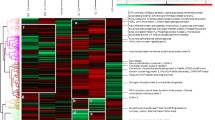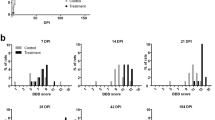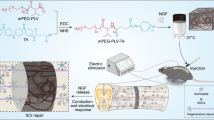Abstract
Background
Spinal cord injury (SCI) and the consecutive devastating neurological sequelae have an enormous individual and economic impact. Implantation of functionalized hydrogels is a promising approach, because they can serve as a matrix for the regenerating tissue, carry and release bioactive molecules and various cell types. We already demonstrated that non-functionalized soft alginate hydrogel supported axonal outgrowth and protected neurons against oxidative stress in vitro. Here, we investigated the effects of such soft alginate hydrogels on locomotor recovery in small and large spinal cord lesions.
Method
Hemimyelonectomy of 2 mm or 4 mm length was performed in rats and soft alginate hydrogel was implanted. Functional recovery of the hindlimbs was assessed in the open field [Batto Beattie Bresnahan (BBB) score] and using swimming test [Louisville Swim score (LSS)] for 140 days post injury (DPI). Reference histology was performed.
Results
Rats that received an alginate implant into 2 mm spinal cord lesions demonstrated significantly improved locomotor recovery compared to controls detectable already at 10 DPI. At 140 DPI, they reached higher LSS and BBB scores in swimming and open field tests, respectively. However, this beneficial effect of alginate was lacking in animals with larger (4 mm) lesions. Histological examination suggested that fibrous scarring in the spinal cord was reduced after alginate implantation in comparison to controls.
Conclusions
Implantation of soft alginate hydrogel in small spinal cord lesions improved functional recovery. Possible underlying mechanisms include the mechanical stabilization of the wound, reduction of secondary damage and inhibition of fibrous scarring.




Similar content being viewed by others
Abbreviations
- SCI:
-
Spinal cord injury
- DPI:
-
Days post injury
- LSS:
-
Louisville Swim score
- BBB:
-
Batto Beattie Bresnahan
- Th:
-
Thoracic level
- GDNF:
-
Glial cell-derived neurotrophic factor
References
Bareyre FM, Kerschensteiner M, Raineteau O, Mettenleiter TC, Weinmann O, Schwab ME (2004) The injured spinal cord spontaneously forms a new intraspinal circuit in adult rats. Nat Neurosci 7(3):269–277
Vipin A, Thow XY, Mir H, Kortelainen J, Manivannan J, Al-Nashash H, All AH (2016) Natural progression of spinal cord transection injury and reorganization of neural pathways. J Neurotrauma 33(24):2191–2201
Anwar MA, Al Shehabi TS, Eid AH (2016) Inflammogenesis of secondary spinal cord injury. Front Cell Neurosci 10:98
Metz GA, Merkler D, Dietz V, Schwab ME, Fouad K (2000) Efficient testing of motor function in spinal cord injured rats. Brain Res 883(2):165–177
Bunge RP, Puckett WR, Becerra JL, Marcillo A, Quencer RM (1993) Observations on the pathology of human spinal cord injury. A review and classification of 22 new cases with details from a case of chronic cord compression with extensive focal demyelination. Adv Neurol 59:75–89
Bunge RP, Puckett WR, Hiester ED (1997) Observations on the pathology of several types of human spinal cord injury, with emphasis on the astrocyte response to penetrating injuries. Adv Neurol 72:305–315
Yuan Y-M, He C (2013) The glial scar in spinal cord injury and repair. Neurosci Bull 29(4):421–435
Brazda N, Müller HW (2009) Pharmacological modification of the extracellular matrix to promote regeneration of the injured brain and spinal cord. Prog Brain Res 175:269–281
Yiu G, He Z (2006) Glial inhibition of CNS axon regeneration. Nat Rev Neurosci 7(8):617–627
Haggerty AE, Oudega M (2013) Biomaterials for spinal cord repair. Neurosci Bull 29(4):445–459
Novikova LN, Novikov LN, Kellerth J-O (2003) Biopolymers and biodegradable smart implants for tissue regeneration after spinal cord injury. Curr Opin Neurol 16(6):711–715
DeVolder R, Kong H-J (2012) Hydrogels for in vivo-like three-dimensional cellular studies. Wiley Interdiscip Rev Syst Biol Med 4(4):351–365
Cardoso MJ, Costa RR, Mano JF (2016) Marine origin polysaccharides in drug delivery systems. Mar Drugs. https://doi.org/10.3390/md14020034
McKay CA, Pomrenke RD, McLane JS, Schaub NJ, DeSimone EK, Ligon LA, Gilbert RJ (2014) An injectable, calcium responsive composite hydrogel for the treatment of acute spinal cord injury. ACS Appl Mater Interfaces 6(3):1424–1438
Suzuki Y, Kitaura M, Wu S, Kataoka K, Suzuki K, Endo K, Nishimura Y, Ide C (2002) Electrophysiological and horseradish peroxidase-tracing studies of nerve regeneration through alginate-filled gap in adult rat spinal cord. Neurosci Lett 318(3):121–124
Suzuki K, Suzuki Y, Ohnishi K, Endo K, Tanihara M, Nishimura Y (1999) Regeneration of transected spinal cord in young adult rats using freeze-dried alginate gel. Neuroreport 10(14):2891–2894
Matyash M, Despang F, Ikonomidou C, Gelinsky M (2014) Swelling and mechanical properties of alginate hydrogels with respect to promotion of neural growth. Tissue Eng Part C Methods 20(5):401–411
Matyash M, Despang F, Mandal R, Fiore D, Gelinsky M, Ikonomidou C (2012) Novel soft alginate hydrogel strongly supports neurite growth and protects neurons against oxidative stress. Tissue Eng Part A 18(1–2):55–66
Teng YD, Lavik EB, Qu X, Park KI, Ourednik J, Zurakowski D, Langer R, Snyder EY (2002) Functional recovery following traumatic spinal cord injury mediated by a unique polymer scaffold seeded with neural stem cells. Proc Natl Acad Sci U S A 99(5):3024–3029
Brechtel K, Tura A, Abdibzadeh M, Hirsch S, Conrad S, Schwab JM (2006) Intrinsic locomotor outcome in dorsal transection of rat spinal cord: predictive value of minimal incision depth. Spinal Cord 44(10):605–613
Konya D, Liao W-L, Choi H et al (2008) Functional recovery in T13-L1 hemisected rats resulting from peripheral nerve rerouting: role of central neuroplasticity. Regen Med 3(3):309–327
Smith RR, Burke DA, Baldini AD, Shum-Siu A, Baltzley R, Bunger M, Magnuson DSK (2006) The Louisville swim scale: a novel assessment of hindlimb function following spinal cord injury in adult rats. J Neurotrauma 23(11):1654–1670
Lee Y-S, Lin C-Y, Jiang H-H, Depaul M, Lin VW, Silver J (2013) Nerve regeneration restores supraspinal control of bladder function after complete spinal cord injury. J Neurosci 33(26):10591–10606
Kataoka K, Suzuki Y, Kitada M, Hashimoto T, Chou H, Bai H, Ohta M, Wu S, Suzuki K, Ide C (2004) Alginate enhances elongation of early regenerating axons in spinal cord of young rats. Tissue Eng 10(3–4):493–504
Kataoka K, Suzuki Y, Kitada M, Ohnishi K, Suzuki K, Tanihara M, Ide C, Endo K, Nishimura Y (2001) Alginate, a bioresorbable material derived from brown seaweed, enhances elongation of amputated axons of spinal cord in infant rats. J Biomed Mater Res 54(3):373–384
Ansorena E, De Berdt P, Ucakar B et al (2013) Injectable alginate hydrogel loaded with GDNF promotes functional recovery in a hemisection model of spinal cord injury. Int J Pharm 455(1):148–158
Krishna V, Konakondla S, Nicholas J, Varma A, Kindy M, Wen X (2013) Biomaterial-based interventions for neuronal regeneration and functional recovery in rodent model of spinal cord injury: a systematic review. J Spinal Cord Med 36(3):174–190
Silva NA, Sousa N, Reis RL, Salgado AJ (2014) From basics to clinical: a comprehensive review on spinal cord injury. Prog Neurobiol 114:25–57
Deng B, Shen L, Wu Y, Shen Y, Ding X, Lu S, Jia J, Qian J, Ge J (2015) Delivery of alginate-chitosan hydrogel promotes endogenous repair and preserves cardiac function in rats with myocardial infarction. J Biomed Mater Res A 103(3):907–918
Sarker B, Singh R, Silva R, Roether JA, Kaschta J, Detsch R, Schubert DW, Cicha I, Boccaccini AR (2014) Evaluation of fibroblasts adhesion and proliferation on alginate-gelatin crosslinked hydrogel. PLoS One 9(9):e107952
Birbrair A, Zhang T, Files DC, Mannava S, Smith T, Wang Z-M, Messi ML, Mintz A, Delbono O (2014) Type-1 pericytes accumulate after tissue injury and produce collagen in an organ-dependent manner. Stem Cell Res Ther 5(6):122
Fernández-Klett F, Priller J (2014) The fibrotic scar in neurological disorders. Brain Pathol Zurich Switz 24(4):404–413
Ahmed Z, Bansal D, Tizzard K, Surey S, Esmaeili M, Gonzalez AM, Berry M, Logan A (2014) Decorin blocks scarring and cystic cavitation in acute and induces scar dissolution in chronic spinal cord wounds. Neurobiol Dis 64:163–176
Estrada V, Brazda N, Schmitz C, Heller S, Blazyca H, Martini R, Müller HW (2014) Long-lasting significant functional improvement in chronic severe spinal cord injury following scar resection and polyethylene glycol implantation. Neurobiol Dis 67:165–179
Klapka N, Hermanns S, Straten G, Masanneck C, Duis S, Hamers FPT, Müller D, Zuschratter W, Müller HW (2005) Suppression of fibrous scarring in spinal cord injury of rat promotes long-distance regeneration of corticospinal tract axons, rescue of primary motoneurons in somatosensory cortex and significant functional recovery. Eur J Neurosci 22(12):3047–3058
Kwon BK, Okon E, Hillyer J, Mann C, Baptiste D, Weaver LC, Fehlings MG, Tetzlaff W (2011) A systematic review of non-invasive pharmacologic neuroprotective treatments for acute spinal cord injury. J Neurotrauma 28(8):1545–1588
Vogelaar CF, König B, Krafft S, Estrada V, Brazda N, Ziegler B, Faissner A, Müller HW (2015) Pharmacological suppression of CNS scarring by Deferoxamine reduces lesion volume and increases regeneration in an in vitro model for Astroglial-fibrotic scarring and in rat spinal cord injury in vivo. PLoS One 10(7):e0134371
Tamosaityte S, Galli R, Uckermann O et al (2015) Biochemical monitoring of spinal cord injury by FT-IR spectroscopy—effects of therapeutic alginate implant in rat models. PLoS One 10(11):e0142660
Steward O, Willenberg R (2017) Rodent spinal cord injury models for studies of axon regeneration. Exp Neurol 287(Pt 3):374–383
Cheriyan T, Ryan DJ, Weinreb JH, Cheriyan J, Paul JC, Lafage V, Kirsch T, Errico TJ (2014) Spinal cord injury models: a review. Spinal Cord 52(8):588–595
Brownstone RM, Bui TV, Stifani N (2015) Spinal circuits for motor learning. Curr Opin Neurobiol 33:166–173
Marder E, Bucher D (2001) Central pattern generators and the control of rhythmic movements. Curr Biol CB 11(23):R986–R996
Kim C-Y (2016) PEG-assisted reconstruction of the cervical spinal cord in rats: effects on motor conduction at 1 h. Spinal Cord 54(10):910–912
Freeman LW (1952) Return of function after complete transection of the spinal cord of the rat, cat and dog. Ann Surg 136(2):193–205
Yoshida Y, Kataoka H, Kanchiku T, Suzuki H, Imajyo Y, Kato H, Taguchi T (2013) Transection method for shortening the rat spine and spinal cord. Exp Ther Med 5(2):384–388
Basso DM, Beattie MS, Bresnahan JC (1995) A sensitive and reliable locomotor rating scale for open field testing in rats. J Neurotrauma 12(1):1–21
Syková E, Jendelová P (2005) Magnetic resonance tracking of implanted adult and embryonic stem cells in injured brain and spinal cord. Ann N Y Acad Sci 1049:146–160
Acknowledgements
The authors thank Mrs. Elke John und Dr. Roland Jung for providing expertise for animal care.
Funding
This research received no specific grant from any funding agency in the public, commercial, or not-for-profit sectors.
Author information
Authors and Affiliations
Corresponding author
Ethics declarations
Conflict of interest
All authors certify that they have no affiliations with or involvement in any organization or entity with any financial interest or non-financial interest in the subject matter or materials discussed in this manuscript.
Ethical approval
All applicable international, national, and/or institutional guidelines for the care and use of animals were followed.
Electronic supplementary material
ESM 1
(DOCX 266 kb)
Rights and permissions
About this article
Cite this article
Sitoci-Ficici, K.H., Matyash, M., Uckermann, O. et al. Non-functionalized soft alginate hydrogel promotes locomotor recovery after spinal cord injury in a rat hemimyelonectomy model. Acta Neurochir 160, 449–457 (2018). https://doi.org/10.1007/s00701-017-3389-4
Received:
Accepted:
Published:
Issue Date:
DOI: https://doi.org/10.1007/s00701-017-3389-4




